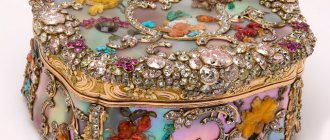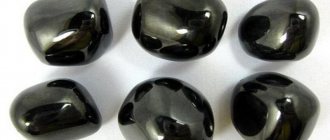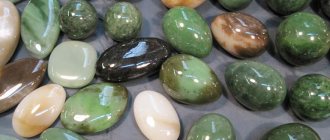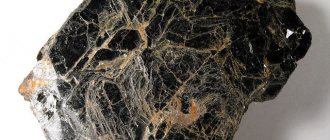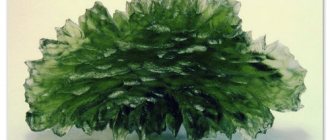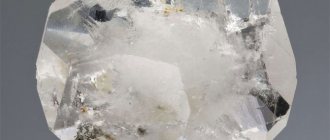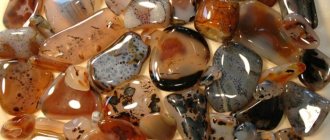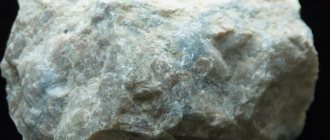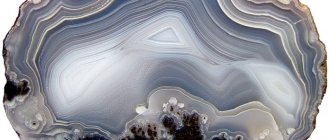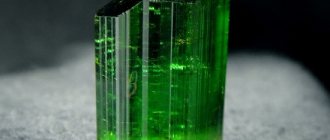| Category | Silicate minerals |
| Title in English | Andalusite |
| Formula | Al2SiO5 |
| Group | Kyanite group |
| Color | Pink, Purple, Yellow, Green, White, Gray |
| Stroke color | White |
| Shine | Glass |
| Transparency | Transparent |
| singonia | Rhombic |
| Hardness | 6,5 — 7,5 |
| Cleavage | Imperfect |
| Density, g/cm³ | 3,12 — 3,18 |
| Kink | Uneven |
| origin of name | This transparent semi-precious stone got its name from the place where it was first found - it happened in Andalusia, a large autonomous region of Spain. |
| Morphology | The stone is most often found in the form of columnar prismatic crystals of considerable size. In addition, there are also columnar and granular aggregates. |
Andalusite is a type of aluminum silicate. The stone is found very often and its properties are similar to other minerals of the silicate group. It is characterized by a high melting point and resistance to acids. Most often, due to these qualities, andalusite is used as a raw material for the refractory and insulating production of fine ceramic materials. Andalusite is used relatively rarely in jewelry, since high-quality crystals are rare, and they are difficult to process.
Andalusite deposits
Previously, andalusite deposits located in Spain were considered the richest, but they have become severely depleted.
Today, deposit development is mostly carried out in Australia, Brazil, Sri Lanka, and the Elbrus region. These regions are the suppliers of high-quality andalusite jewelry crystals. — Advertising —
In addition, there are mines in Canada, the USA, Russia, Germany, and Kazakhstan.
Andalusite deposits are various shales: clayey, carbonaceous-clayey, mica, secondary quartzites.
Description of the stone
Andalusite is a stone that is an aluminum silicate. It got its name in honor of the city of Andalusia, located in Spain.
It is a hard, durable mineral, the appearance depends on the variety. Mineralogists distinguish the following types of rock:
- Chiastolite (kyastolite). Opaque or translucent mineral of brown, yellow, gray, orange shades. Its main feature is a pattern in the form of a dark (dark gray or black) cross, which is formed from carbon inclusions. The stone was used by priests in their attributes and dedicated to the Holy Mother of God.
- Titanium andalusite. The most durable stone containing titanium impurities. Used in construction, the metallurgical industry, and used to create fire-resistant materials.
- Viridin. Contains large amounts of iron and manganese. Transparent stone of brown, greenish, pink and other shades. Yellow and green specimens have the effect of pleochroism. They shimmer in different colors in the light, regardless of the lighting (this is different from alexandrite). Pink andalusites do not have this ability.
Expensive varieties of andalusite are found in yellow, green, and blue shades.
The stone was first mined in Spain. At the moment, its deposits there are almost completely depleted. Currently, crystal mining is carried out in the following countries:
- The largest deposits are located in Canada, the USA, Ukraine, Turkey, Australia, China, and Slovakia.
- In Russia (Transbaikalia, Siberia, KRB, Nerchinsk, Elbrus region, and the Urals), industrial and jewelry andalusite is mined.
- The Asian jewelry triangle is considered a supplier of rare blue crystals. It includes Ceylon, Burma, India.
- Expensive green minerals are supplied by Spain, Austria, Myanmar, Switzerland, and China.
- Blue andalusite is mined in Belgium.
- Stones for the production of refractory materials are found in Brazil, Sri Lanka, Italy, and Germany.
- Olive-colored andalusite is mined in Brazil. Large, expensive specimens were found there.
- The Pamirs also boast large gem-quality nuggets.
A common method of authentication for all varieties is to run a stone across the glass and then see if there is a scratch. The mineral is hard enough to scratch glass and softer rocks.
Chiastolite is identified by the presence of a cross-shaped pattern that is not erased, and viridin is distinguished by its ability to pleochroism.
View this publication on Instagram
Publication from Aliskina Skazki (@aliskin_skazki) February 16, 2021 at 7:22 PST
History of andalusite
The aluminum silicate andalusite was first described at the end of the 18th century by the French mineralogist Delameterrier.
Specimens of the gem were discovered in Andalusia (Spain), and were named after the place of discovery. Natural stones usually form granular aggregates or individual prismatic columnar crystals that can grow to large sizes.
— Advertising —
Andalusites are also often found under numerous synonymous names, including viridines, hard spars, stanzaites, apyres, micaphyllites, and cousinranites.
Medicinal properties
Lithotherapists use andalusite in healing practices to stimulate blood flow, normalize the functioning of the cardiovascular system, and eliminate the effects of stress. The effect of the mineral has a beneficial effect in the comprehensive fight against excess weight.
All types of stone help to calm down, discard everything unnecessary, concentrate and find a way out of a difficult situation, which is why it is often used in the treatment of nervous disorders.
Andalusite is known for its general strengthening effect on the human body. The gem is used in the treatment of diseases of the respiratory system, for which it is recommended to wear jewelry with it on the chest.
When choosing a suitable sample for lithotherapy, it is worth paying attention to untreated pieces of rock, the structure and integrity of which has had minimal external influence.
Physico-chemical characteristics of andalusite
In terms of its chemical composition, andalusite is a complex aluminum-silicon salt with admixtures of iron and manganese oxides, as well as carbonaceous and clayey substances.
The andalusite crystal is thick-tabular, columnar, columnar, or is a granular intergrowth, with an orthorhombic system and imperfect cleavage.
The color palette of andalusites includes mainly warm shades of gray, yellow, brown, golden, orange-brown and pink. Less common are red and dark green stones. But colorless andalusites are a real rarity.
The stone is characterized by pleochroism; it changes its color depending on the angle of incidence of sunlight: yellow-green andalusite becomes reddish-brown or dark red. Yellowish-green luminescence is weakly expressed.
The stone has a glassy luster and is transparent or translucent. Hardness 7.5 on the Mohs scale. The density is 3.12-3.18 g/cm3. Uneven at the break.
The melting point of andalusite reaches 1380 °C.
Associated minerals are corundum, diaspores, muscovites, topazes, pyrophyllites, and rutiles. Alexandrite is the most similar stone to andalusite.
Types of andalusite
The following varieties are distinguished for andalusite:
- Chiastolits, cross stones or cross stones. This is an opaque variety of the mineral, on the cross section of which, when processed, a dark cross becomes noticeable. Its formation is explained by selective absorption by the stone faces during growth of particles of coal and clay from the accompanying rock. This feature of the stone is indicated by its name, which goes back to the Greek words “hiastos” and “lithos”, meaning “crossed” and “stone”.
- Viridin is a type of andalusite with a high content of manganese oxide. This species is characterized by a rich green-herbaceous hue.
- Titanium andalusite – as the name suggests, contains an admixture of titanium.
Mystical energy of stone
Andalusite has been valued for its magical properties for many centuries. The gem is used in rituals and esoteric practices as an amulet that promotes the enlightenment of the spirit, the opening of consciousness, and the transition to trance. It helps to contact spiritual entities and connect to the general information flow. Therefore, all varieties of the mineral are used in various meditative practices.
Andalusite is often called the “seeing stone,” emphasizing its ability to clear the mind of foreign influences and false ideas. Crystal helps to see the essence of things and people.
Due to the characteristic cross-shaped pattern, there were many legends and beliefs surrounding the chiastolite. The Knights of the Order of Malta believed that these stones were drops of the blood of Christ; in other legends, the design in the form of a cross was the petrified tears of fairies.
Traditionally, chiastolite is considered a strong amulet against negativity; warriors wore talismans with this mineral.
In addition, it promotes the manifestation of communication skills, so it is suitable for people whose activities involve communicating with an audience or working with animals or plants.
The magical properties of andalusite
Interestingly, andalusite is not a precious or semi-precious stone, but its magical abilities are equal to those of many famous gems.
Andalusite was and remains a popular mineral among sorcerers and magicians who communicate with otherworldly forces. It is also used to achieve a state of trance and enhance psychic abilities. In addition, fortune tellers also use andalusite. According to legends, the famous soothsayer Nostradamus valued this mineral very much, and always had an andalusite jewelry or amulet with him.
It is believed that andalusite is a good helper for everyone who is engaged in comprehending the secrets of life and the universe, trying to comprehend sacred knowledge and facilitating the transition to higher levels of thinking.
STONE PROPERTIES AND APPLICATION
- Andalusite is good for melancholic, phlegmatic, and sanguine people.
- For the work of the crystal in magic and lithotherapy, the days of the first quarter of the moon and the 4th and 5th days of the full moon are especially recommended.
- For those who are passionate about yoga, it is recommended to meditate on the stone before solving any problem.
- Chakra - Vishuddha.
The magical properties of andalusite
- The cross could not help but interest the clergy.
- Rosaries, rings, and crosses are made from stone.
- Esotericists appreciated the beauty and magical properties of the gem. It is believed that it facilitates communication with intangible entities, with the spirits of the departed.
- The crystal helps in communicating with the natural world, which includes humans, animals, and plants.
- Uncut stones help keep a cool head in stressful situations.
- Andalusite protects against the evil eye and damage. While in the house, it will protect the home from accidents, thieves, and unwanted guests.
Chiastolite
They believe that the stone will only help for noble purposes.
Andalusite does not accept those seeking enrichment and personal gain.
Andalusite in lithotherapy
According to lithotherapists, crystals are used in the treatment of:
- diseases of the lungs and respiratory system;
- circulatory system, blood vessels;
- immune system;
- hypertension;
- insomnia;
- stress, depression.
We recommend: SOAP - the warmth of our home
Contraindicated in diabetes mellitus and lupus erythematosus.
Compatibility with Zodiac and names
Andalusite is friendly and refuses to help anyone. The main thing is that the person is not aggressive or angry. The crystal will try to get away from such an owner - it will simply get lost.
Andalusite's favorite zodiac signs are Libra and Gemini.
Suitable for people with names that begin with “A”, “G”, “K”. Especially suitable for Andrey and Christina.
Branches of application of andalusite
Andalusite spread and became popular during the Middle Ages.
Then the attention of the Knights Templar, who conducted trade relations with the Cordoba Caliphate, was drawn to its unusual subspecies of chiastolite. From there they received yellowish-orange stones, the cut of which had a clearly visible cross pattern with extensions at the ends. Since this particular cross was the symbol of the Templar Order, it quickly became popular among knights to purchase rings and amulets with andalusites. In addition, the gem began to be used in mysterious knightly rituals. Representatives of other church orders also gradually introduced andalusite into their culture. Later, when other varieties of andalusite were discovered, and deposits with high-quality crystals were found, and craftsmen learned to cut the stone, andalusite began to be used in jewelry.
Nevertheless, the majority of mined andalusite today is used for industrial purposes in the production of fine ceramic products.
Interesting Facts ?
Beads, rings, and amulets are still made from chiastolite. They are in demand among believers and representatives of subcultures.
One of the colors of Andalusite, that is, yellowish, has been recognized as the most important healing stone.
The color and hardness of andalusite make it suitable for men's jewelry.
Andalusite is considered to be a stone that has some mystical properties; hence, it is used as a talisman against the evil eye.
Andalusite becomes a powerful stone when used in combination with natural diamonds and citrine.
To benefit from the healing properties of andalusite, it should be worn directly on the skin or held in the hand.
Kiastolite is considered the most precious form of andalusite stone.
The ancient Greeks used these extravagant crystals for medicinal and decorative purposes.
When cutting, a good jeweler will try to ensure that the pleochroism of the stone is most clearly revealed.
Andalusite colors
Natural andalusites are characterized by golden, yellow, yellow-green and brown tones in color.
Pink, gray, red, brown stones are less common. The color of andalusite is determined by the impurities that are included in its composition. The stone is characterized by the ability to change color from different angles of view, that is, pleochroism. By turning the sample from side to side, you can enjoy the beautiful play of colors.
Pure colorless specimens of andalusite are extremely rare and are always used for jewelry purposes.
Story
Even before the 18th century, there was a stone in Europe that was called “cross stone”, because of its characteristic feature, after processing, it showed the resemblance of a simple cross on the surface. It is possible that it was the alchemist Nostradamus who used it in the form of an amulet on a pendant. Similar descriptions exist about the “cross” in the legends about the order of knights and monks. This stone can be considered andalusite due to its characteristic pattern and color palette.
The first scientific mention of andalusite dates back to 1754, when the Spanish author Torrubia, in his book “The Structure of the Natural History of Spain,” described “crossstone” as a type of chryostolite, without giving it a unique name.
Later, the presence of natural andalusite in rocks was recorded by the German geologist, founder of diagnostic classification and descriptive mineralogy, Abraham Gottlieb. He described the mineral and indicated its location in Andalusia (autonomous region of Spain), but research showed that the deposit was actually located in the autonomous region of La Castillo, adjacent to Andalusia, near the city of Guadalajara. This location is not accidental, as the name of the city (distorted Arabic means river of stones). Werner’s mistake about the place of origin of the “cross stone” was repeated by Delametre, who was the first to connect the name of the province and the name of the stone. In 1798 he gave it the name Andalusite.
How to care for andalusite
Andalusite is a durable and reliable stone.
It is unpretentious in terms of handling and storage. It is not recommended to leave the mineral in the sun for a long time and expose it to chemicals. To clean jewelry with andalusite, use a soap solution and a soft brush, after which the product is washed with running water and dried.
NUANCES OF CHOICE AND CARE
How to distinguish from a fake
It is better to take the jewelry to a gemologist or jeweler, but there are tips “for home use”:
- You can simply twirl Viridin in your hands - the edges of the crystal will change color.
- It is advisable to examine chiastolite, its part with a cross, grid or diamond pattern under a magnifying glass - the color transitions of natural stone are smooth, soft, the pattern maintains symmetry.
- You can simply scratch the glass with the mineral. Andalusite is harder and should leave a streak on the glass. You shouldn’t be too zealous; you can crush the “cutting” edge of the crystal.
The price per gram may vary depending on the size of the stone, its cut, purity and location of extraction.
Over the past 10 years, the price of cut andalusite has increased 70 times.
| Carat weight | Country of origin | Type of cut | approximate price |
| 1,6 | Brazil | marquis | 6200 |
| 0,3 | Sri Lanka | circle | 1200 |
| 3,65 | Brazil | a drop | 9900 |
Authentication
Proper care of the gem
Crystal is not fussy to care for, but it also needs care:
- Rinse in warm soapy water when soiled, then rinse with running clean water.
- Aggressive liquids are not recommended; a regular mild shampoo works well.
- It is better to store jewelry in a separate case or simply in a gripper.
If a stone is used for magical purposes, it must be regularly cleansed of “energetic dirt”. To do this, rinse the jewelry in running water and place it in table salt.
We recommend: All world QUARTZ DEPOSITS
Salt is a powerful energy purifier. A few hours “on the salt beach”, rinsing the crystal in water - and it is again ready to protect the owner.
Throw away the used salt: it has absorbed negativity from the stone.
Andalusite and zodiac sign
Andalusite is universal and gets along well with representatives of absolutely all zodiac signs. The stone is more sensitive to the intentions of its owner and his character and inclinations. Thus, it is believed that anyone who plans some evil deed or decides to get rich dishonestly with the help of andalusite will lose the stone or amulet.
Who is the stone suitable for according to their zodiac sign?
Andalusite will be an excellent talisman for all representatives of the zodiac constellations. It can be used by everyone without exception; it cannot harm anyone.
It is advisable to use the amulet for people in professions that are aimed at helping other people; it is great for rescuers, medical workers, researchers, priests, and teachers.
Helpful information
The gem can only be used by individuals with pure and noble thoughts, but if a person wants to receive material benefits, experiences envy and hatred of others, then his talisman will soon be lost.
Astrologers recommend wearing the gem to all zodiac signs.
Prices for andalusite products
Andalusites of high jewelry quality are quite rare, they are difficult to process, and therefore are not particularly popular among jewelers. However, the price of jewelry andalusite is constantly growing and has increased significantly over the past few decades. So, today a small andalusite of jewelry quality is estimated at 15-25 dollars per carat. But the price for high-quality Brazilian andalusites of an unusual pink-green color with pronounced pleochroism starts at $250-300 per carat, which is comparable to high-quality chrysoberyl. The average weight of such a cut stone rarely exceeds 5 carats, and the cut is round, oval or teardrop-shaped emerald.
Interesting facts about andalusite:
- A talisman or amulet with andalusite is suitable for all people associated with mental activity. It is recommended to purchase it for a doctor, scientist, theologian, monk and priest. The mineral is also the patron saint of the military during battles and battles; it is not recommended to wear it during peacetime.
- Due to its pronounced pleochroism, andalusite was once often called “the poor man’s alexandrite.” Unlike the latter, turning at a different angle is enough to change the shade of andalusite, while alexandrite needs a change in lighting.
